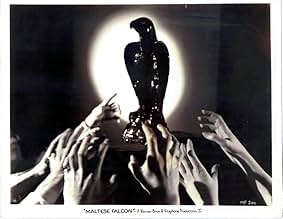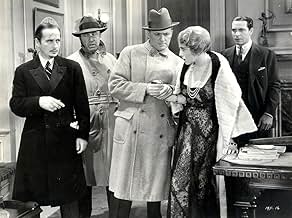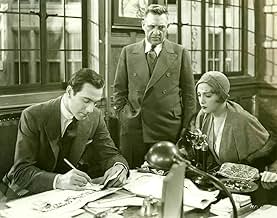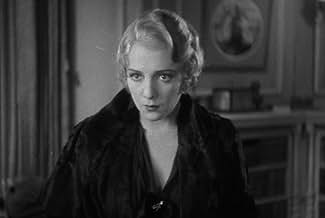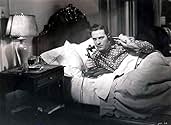IMDb RATING
6.8/10
3.5K
YOUR RATING
A lovely dame with dangerous lies employs the services of a private detective, who is quickly caught up in the mystery and intrigue of a statuette known as the Maltese Falcon.A lovely dame with dangerous lies employs the services of a private detective, who is quickly caught up in the mystery and intrigue of a statuette known as the Maltese Falcon.A lovely dame with dangerous lies employs the services of a private detective, who is quickly caught up in the mystery and intrigue of a statuette known as the Maltese Falcon.
- Awards
- 2 wins total
Agostino Borgato
- Capt. John Jacobi
- (uncredited)
Tiny Jones
- Jailbird Seeking Cigarette
- (uncredited)
Cliff Saum
- Baggage Clerk
- (uncredited)
Morgan Wallace
- District Attorney
- (uncredited)
Lucille Ward
- Sarah - Prison Matron
- (uncredited)
Featured reviews
The 1941 version of The Maltese Falcon starring Humphrey Bogart was actually the second remake of The Maltese Falcon. The first remake was Satan Met A Lady, (1936) starring Bette Davis. This film (The Maltese Falcon - 1931) was the original. It doesn't have the pizazz of the Humphrey Bogart version, and it is not a film noir version, but it is extremely faithful to the story, and much more explicit about the various adulterous affairs, out of wedlock sex, and homosexuality. Ricardo Cortez was a big star at the time.
Contrary to the many comments in user reviews, it is not a pre-code movie. The Movie Production Code (aka Hays Code) was instituted in 1930, but largely ignored by the studios. It wasn't enforced until 1934 when Joseph Breen took over as head of the Motion Picture Code. The story of the years 1930 - 1933 films which contained much more explicit material than was technically permitted by the code is well told in the TCM documentary "Forbidden Film".
Of the three versions of The Maltese Falcon, this is, in my opinion, the second best, with Bogart's version being the best. But this version is a close second, with much to recommend it. It is not more faithful to the novel than the 1941 version, but it is much clearer, especially concerning the sexual sub-plots of the film. It was an A movie in it's time, with top stars including Thelma Todd, Una Merkel, and Dwight Frye. If you like the Bogart version you will probably enjoy this antecedent. Film aficionados and lovers of film history should take special note of this gem.
Contrary to the many comments in user reviews, it is not a pre-code movie. The Movie Production Code (aka Hays Code) was instituted in 1930, but largely ignored by the studios. It wasn't enforced until 1934 when Joseph Breen took over as head of the Motion Picture Code. The story of the years 1930 - 1933 films which contained much more explicit material than was technically permitted by the code is well told in the TCM documentary "Forbidden Film".
Of the three versions of The Maltese Falcon, this is, in my opinion, the second best, with Bogart's version being the best. But this version is a close second, with much to recommend it. It is not more faithful to the novel than the 1941 version, but it is much clearer, especially concerning the sexual sub-plots of the film. It was an A movie in it's time, with top stars including Thelma Todd, Una Merkel, and Dwight Frye. If you like the Bogart version you will probably enjoy this antecedent. Film aficionados and lovers of film history should take special note of this gem.
This is a fascinating version of the story definitively filmed ten years later by John Huston, because of the ways in which it comes close to capturing the Hammett novel-- and the ways in which it doesn't. As a pre-Code film it's often more explicit than the Huston version-- especially about the fact that Spade was having an affair with his partner's wife, and about the homosexuality of the male crooks (this movie's Gutman is plainly depicted as a seedy john rather than as the refined aesthete Sydney Greenstreet would play). But hardboiled attitude is what really matters, and Ricardo Cortez (a good early talkie actor who always tried hard) just isn't playing Hammett's hardboiled, unsentimental Spade-- he's playing the more typical suave gentleman detective of the period, like Philo Vance. As a result, it's the love affair with Ms. Wonderly that takes over, and the shocking bite of Hammett's ending is lost. It was capturing the Hammett worldview that was John Huston's great accomplishment, and that made his Falcon so influential over the films noir to follow.
All the same Huston, who was working at Warner Bros. when this was made, must have liked something about this movie-- the scene where Spade first meets Joel Cairo (Otto Mattiesen, doing an excellent Peter Lorre imitation years before the fact) is repeated almost shot for shot and inflection for inflection in the Huston version, the only such case of direct inspiration I spotted here. Mattiesen, a familiar silent era character actor, sadly died not long after the film came out; had he lived he certainly could have had as interesting a talkie career as Lorre eventually did.
All the same Huston, who was working at Warner Bros. when this was made, must have liked something about this movie-- the scene where Spade first meets Joel Cairo (Otto Mattiesen, doing an excellent Peter Lorre imitation years before the fact) is repeated almost shot for shot and inflection for inflection in the Huston version, the only such case of direct inspiration I spotted here. Mattiesen, a familiar silent era character actor, sadly died not long after the film came out; had he lived he certainly could have had as interesting a talkie career as Lorre eventually did.
In 1931 Roy Del Ruth became the first director to bring Dashiell Hammett's THE MALTESE FALCON to the screen. Although it received favorable reviews and did a brisk business at the box office, like many early talkies it was soon eclipsed by ever-advancing technology and forgotten--until television, with its endless demands for late-late show material, knocked on Hollywood's door. Retitled DANGEROUS FEMALE in order to avoid confusion with the highly celebrated 1941 version, it has haunted the airwaves ever since.
DANGEROUS FEMALE is interesting in several ways, and perhaps most deeply so as an example of the struggle that ensued when sound first roared. What had proved effective on the silent screen suddenly seemed highly mannered when voices were added, and both directors and stars struggled to find new techniques--and DANGEROUS FEMALE offers a very vision of the issues involved.
It is a myth that the advent of sound forced directors to lock down the camera, but it is true that many directors preferred simple camera set-ups in early sound films; it gave them one less thing to worry about. And with this film, Roy Del Ruth is no exception: in a visual sense, DANGEROUS FEMALE is fairly static. The performing decisions made by the various actors are also illustrative and informative, particularly re leads Ricardo Cortez and Bebe Daniels. Cortez is still clearly performing in the "silent mode," and he reads as visually loud; Daniels, however, has elected to underplay, and while she is stiff by current standards, her performance must have seemed startlingly innovative at the time. And then there are two performers who are very much of the technology: Una Merkle as Spade's secretary and Thelma Todd as Iva Archer, both of whom seem considerably more comfortable with the new style than either Cortez or Daniels.
The film is also interesting as a "Pre-Code" picture, for it is sexually explicit in ways most viewers will not expect from a 1930s film, and indeed it is surprisingly explicit even in comparison to other pre-code films. Hero Sam Spade is a womanizer who seduces every attractive female who crosses his path--and the film opens with a shot of just such a woman pausing to straighten her stockings before leaving his office. Still later, the dubious Miss Wonderly tempts Spade with her cleavage, lolls in his bed after a thick night, splashes in his bathtub, and finally winds up stripped naked in his kitchen! It is also interesting, of course, to compare DANGEROUS FEMALE to its two remakes. Directed by William Dieterle and starring Warren William and Bette Davis, the 1936 Satan MET A LADY would put Hammett's plot through the wringer--and prove a critical disaster and a box office thud. But then there is the justly celebrated 1941 version starring Humphrey Bogart and Mary Astor under the direction of John Huston.
Both the 1931 and 1941 films lifted great chunks of dialogue from Hammett's novel, and very often the dialogue is line-for-line the same. But two more completely different films could scarcely be imagined. Where the 1931 film strives for an urbane quality, the 1941 film is memorably gritty--and in spite of being hampered by the production, considerably more sexually suggestive as well, implying the homosexuality of several characters much more effectively than the 1931 version dared.
In the final analysis, the 1931 THE MALTESE FALCON (aka DANGEROUS FEMALE) will appeal most to those interested in films that illustrate the transition between silent film and sound, to collectors of "pre-code" movies, and to hardcore FALCON fans who want everything associated with Hammett, his novel, and the various film versions. But I hesitate to recommend it generally; if you don't fall into one of those categories, you're likely to be unimpressed.
Gary F. Taylor, aka GFT, Amazon reviewer
DANGEROUS FEMALE is interesting in several ways, and perhaps most deeply so as an example of the struggle that ensued when sound first roared. What had proved effective on the silent screen suddenly seemed highly mannered when voices were added, and both directors and stars struggled to find new techniques--and DANGEROUS FEMALE offers a very vision of the issues involved.
It is a myth that the advent of sound forced directors to lock down the camera, but it is true that many directors preferred simple camera set-ups in early sound films; it gave them one less thing to worry about. And with this film, Roy Del Ruth is no exception: in a visual sense, DANGEROUS FEMALE is fairly static. The performing decisions made by the various actors are also illustrative and informative, particularly re leads Ricardo Cortez and Bebe Daniels. Cortez is still clearly performing in the "silent mode," and he reads as visually loud; Daniels, however, has elected to underplay, and while she is stiff by current standards, her performance must have seemed startlingly innovative at the time. And then there are two performers who are very much of the technology: Una Merkle as Spade's secretary and Thelma Todd as Iva Archer, both of whom seem considerably more comfortable with the new style than either Cortez or Daniels.
The film is also interesting as a "Pre-Code" picture, for it is sexually explicit in ways most viewers will not expect from a 1930s film, and indeed it is surprisingly explicit even in comparison to other pre-code films. Hero Sam Spade is a womanizer who seduces every attractive female who crosses his path--and the film opens with a shot of just such a woman pausing to straighten her stockings before leaving his office. Still later, the dubious Miss Wonderly tempts Spade with her cleavage, lolls in his bed after a thick night, splashes in his bathtub, and finally winds up stripped naked in his kitchen! It is also interesting, of course, to compare DANGEROUS FEMALE to its two remakes. Directed by William Dieterle and starring Warren William and Bette Davis, the 1936 Satan MET A LADY would put Hammett's plot through the wringer--and prove a critical disaster and a box office thud. But then there is the justly celebrated 1941 version starring Humphrey Bogart and Mary Astor under the direction of John Huston.
Both the 1931 and 1941 films lifted great chunks of dialogue from Hammett's novel, and very often the dialogue is line-for-line the same. But two more completely different films could scarcely be imagined. Where the 1931 film strives for an urbane quality, the 1941 film is memorably gritty--and in spite of being hampered by the production, considerably more sexually suggestive as well, implying the homosexuality of several characters much more effectively than the 1931 version dared.
In the final analysis, the 1931 THE MALTESE FALCON (aka DANGEROUS FEMALE) will appeal most to those interested in films that illustrate the transition between silent film and sound, to collectors of "pre-code" movies, and to hardcore FALCON fans who want everything associated with Hammett, his novel, and the various film versions. But I hesitate to recommend it generally; if you don't fall into one of those categories, you're likely to be unimpressed.
Gary F. Taylor, aka GFT, Amazon reviewer
DWIGHT FRYE plays Wilmer Cook in this version! Imagine my amazement at finding this out. Don't get me wrong, Elisha Cook Jnr. was extremely good in the later version and Dwight's role is considerably smaller but if you asked me to pick which one was the deffinitive Wilmer I would have a very hard time. The role does not call for subtlety; Wilmer is a psychotic who enjoys his work a little too much. Both men do an admirable job playing a role that is more complex than appears on the surface. The audiences first impression is to laugh at the baby faced kid waving his big .45 automatics around and talking tough but as soon as we find out that not only is he not shy about using his weapons he is darn good with them too he becomes a frightening image because his young, fresh faced looks hide a true monster beneath the surface. Well done, Dwight. I have a new respect for this hard-to-find early version of the famous novel now and it's all thanks to you.
Despite the silent-to-talkie transition style, I liked this one better than the Bogart one. In fact, I think it exposes Bogart's counterfeit toughness (among other things, he was too short). Ricardo Cortez was a great choice. Perhaps George Raft might have been a better Sam Spade in the 1941 version. The similarity in dialogue between the two movies begs the issue of insufficient originality in the later version.
Comparing 1931 v 1941 characters, I think only Sydney Greenstreet provides a more interesting product. As the same (or similar) character, Alison Skipworth, as Madame Barabbas in Satan Met a Lady 1936, finishes second. From that same movie, Marie Wilson finishes second to Una Merkel as Effie, with 1941's Lee Patrick a distant third.
I like them all. I like the structure of the mystery. It reminds me (it's just me) a little of John Le Carre mysteries where, as in Tinker Tailor, the investigator knows the answer from the beginning.
Comparing 1931 v 1941 characters, I think only Sydney Greenstreet provides a more interesting product. As the same (or similar) character, Alison Skipworth, as Madame Barabbas in Satan Met a Lady 1936, finishes second. From that same movie, Marie Wilson finishes second to Una Merkel as Effie, with 1941's Lee Patrick a distant third.
I like them all. I like the structure of the mystery. It reminds me (it's just me) a little of John Le Carre mysteries where, as in Tinker Tailor, the investigator knows the answer from the beginning.
Did you know
- TriviaArt director Robert M. Haas performed the same function on Le faucon maltais (1941).
- GoofsThe same prop is used for the suitcase that Spade finds in Miss Wonderly's room and the suitcase which contains the falcon. The travel stickers are identical on each one.
- Quotes
Effie Perrine: Sam, it's a gorgeous new customer.
Sam Spade: Gorgeous?
Effie Perrine: A knockout.
Sam Spade: Send her right in, honey.
Effie Perrine: [to the off-screen customer] Will you step in, please?
[Joel Cairo walks in.]
- ConnectionsFeatured in Great Performances: Bacall on Bogart (1988)
- How long is The Maltese Falcon?Powered by Alexa
Details
- Runtime
- 1h 20m(80 min)
- Color
Contribute to this page
Suggest an edit or add missing content

